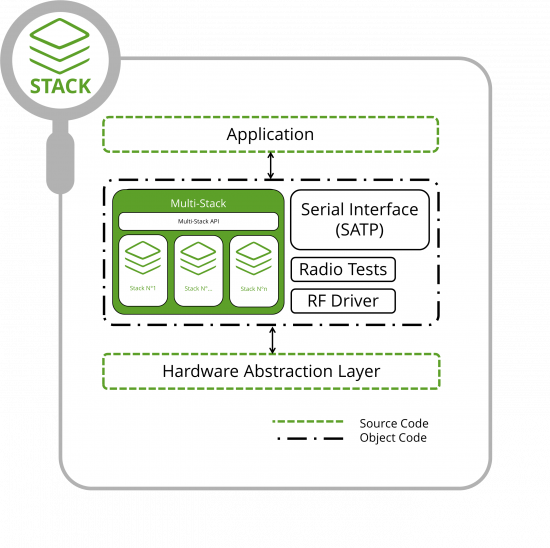In modern IoT applications, flexibility and responsiveness are essential. Varying environmental conditions, network infrastructures, and use cases require the integration of different wireless communication technologies. A single-protocol solution is often not enough. The answer: Multi-Protocol Stacks. They enable the simultaneous use of multiple wireless communication protocols on a single device – tailored to the application.
What is a Multi Stack?
A Multi Stack combines multiple protocol stacks within a common software architecture. Depending on the use case, the appropriate protocol can be selected either manually or automatically – even during runtime. Whether it's LoRaWAN®, mioty®, or Wireless M-Bus (OMS®) – a Multi Protocol Solution allows flexible switching between technologies or operating them in parallel.
Architecture and Chip Design: Multi Stack on a Single MCU
In terms of basic architecture, a Multi Stack differs only slightly from a traditional single stack – the key difference lies in the ability to run multiple protocols either simultaneously or in sequence. Data is transmitted unidirectionally or bidirectionally, depending on the protocol, using predefined communication parameters.

One-Chip vs. Two-Chip Design
STACKFORCE Multi Stacks are designed for both One-Chip and Two-Chip architectures. A One-Chip design with only one MCU can provide significant advantages: reduced cost, smaller hardware footprint, and easier integration. However, it is important to consider that combining multiple protocols generally requires more memory – careful planning is therefore essential.
Multi Stack API: Control, Switching and Prioritization Made Easy
A core component of the STACKFORCE Multi Stack Solution is the well-structured API (Application Programming Interface). It offers a unified interface for managing all integrated protocol stacks – regardless of whether they operate in parallel or alternately.
The API enables the simultaneous operation of multiple protocols on a single MCU – provided there are no technical conflicts. Alternatively, protocols can be switched based on time schedules or triggered by specific events. The following switching strategies can be defined individually:
- Condition-based: Switch protocol when signal is lost, energy levels change, or network availability varies
- Priority-based: Protocol X takes precedence over Protocol Y when certain conditions are met
- Time-based: Use specific protocols at predefined times
This logic is fully controlled through the API and can be dynamically adjusted – even during runtime.
Seamless Migration from Single Stack to Multi Stack
Already using a STACKFORCE Single Stack? The migration to a Multi Stack is straightforward and efficient: simply replace the existing single stack library with the multi stack version. The application only needs to be extended to address the additional protocols. Thanks to the unified API architecture, all previous configurations can be retained – only the newly added stack needs to be adapted to the application’s needs.
Good to know: Unused protocols can be temporarily deactivated or completely removed – saving memory and freeing up resources for additional functions.
Why Choose a Multi Protocol Solution?
The benefits at a glance:
- Improved network coverage
- Greater flexibility and extended communication range
- Reduced integration effort
- More efficient use of hardware resources
- Ideal for mobile and stationary applications
Multi Stack Solutions are the answer to heterogeneous communication requirements – whether due to varying infrastructure or complex use cases.
Real-World Application Examples
Smart Metering: Local & Remote in One Device
In consumption data collection, Wireless M-Bus is the go-to technology for walk-by or drive-by scenarios. A device equipped with a Multi Protocol Stack can additionally transmit data via LoRaWAN® or mioty® over LPWAN – fully automated, no manual reading required, and with significantly extended range. This makes it possible to seamlessly combine stationary and mobile reading scenarios.
Mobile Assets: Always Connected
Example: A brewery monitors its beer kegs using integrated sensors. While on site, the data is transmitted via LoRaWAN®. Once a keg leaves the premises, the public Sigfox network takes over – ideal for mobile tracking. When the keg returns to the brewery, the system automatically switches back to the local LoRaWAN® network for detailed sensor data communication.
When Is a Multi Stack the Right Choice?
In most cases, a Multi Protocol Solution is the future-proof choice – especially when flexibility, scalability, and long-range communication are critical. However, for very compact applications with minimal memory requirements, a single protocol stack may be the better option. The decision should be made based on individual needs, including energy constraints and system environment.
Our recommendation: Those who plan ahead choose a Multi Stack Solution from the beginning – and benefit from the combined strengths of multiple protocols.
Want to know if a Multi Stack fits your project?
Contact us – we’ll advise you individually toward any specific technology.

